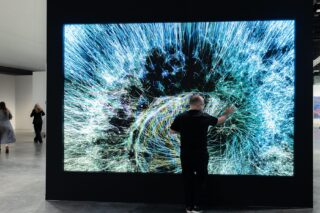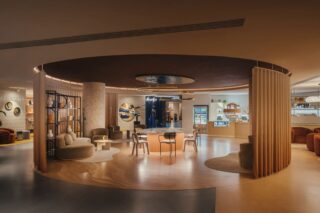In May at the Brooklyn Expo Center in the Greenpoint neighborhood, the design fair Bklyn Designs is one of the most vibrant shows in New York City and one of the anchors of the citywide NYCxDESIGN initiative. It showcased the wares of designers from the trendsetting borough, which, according to some accounts, gave birth to the hipster lifestyle.
The emphasis throughout the show was on clean, modern lines with little reference to decorative frills. This being hipster Brooklyn, there also was a fair amount of wood furniture with an emphasis on environmental concerns and recycling.
One of the most striking displays was from Greenery NYC, which brings the outdoors indoors with various plant installations. This includes low-maintenance interior wall dividers comprised of plants, plant islands, shelving units made of plants and even ivy-covered interior columns. One key aspect is watering systems that can go for weeks without refilling.
“The idea is to make it so the customer doesn’t get saddled with large opportunity costs,” said Rebecca Bullene, the company’s founder, who has greened the offices of e-commerce giant Etsy and the New York headquarters of Ted Talks.
A standout among the many wood craftspeople displaying was Mark Jupiter, who uses reclaimed wood from rare species in about 50 percent of his pieces. There was a rich grained wood and metal cabinet made from what Jupiter said was probably two-thousand-year-old redwood from the remains of an old New York City water tower. Jupiter also showed a bench made from old warehouse beams put through a Japanese wood firing technique called Shou Sugi Ban, which results in a textured black alligator skin-like surface.
For a borough with so many hipster millennials who make their living with technology, it was striking to see displays by designers who sought to minimize or camouflage the gadgets that are proliferating throughout the modern home. The design firm Onebutton showed speakers all but invisible within sheetrock walls, wallpaper-thin televisions and stylish custom light switches that looked like knobs embedded in brass plates.
The Connected Home exhibition, by the Brooklyn based electronics store AJ Madison and interior designer Gunnar Larson, featured WiFi-enabled and certified energy-saving appliances from Frigidaire, GE, LG, Bosch and Samsung. Larson’s streamlined design gave them a subdued look, resulting in a slightly retro kitchen.
“A lot of technology is cold,” explained Larson, a tall young man with a hipster beard, referring to his inspiration for making a display that evokes a simpler time.
A Master at Working Wood
During the May event, internationally acclaimed Irish furniture designer Joseph Walsh came to New York City, where his work was both the subject of a panel discussion at the New York School of Interior Design and an extensive exhibition at the elegant Fifth Avenue Beaux-Arts townhouse that serves as the headquarters of the Irish American Historical Society.
“Nobody has pushed the boundaries of design like this since Michael Thonet ,” declared the prominent design curator and scholar Glenn Adamson at the panel discussion.
This 19th-century German designer is the inventor of bentwood furniture. A series of slides showed Walsh’s limited edition pieces, including an enormous, elliptical wood sculpture that appears to defy gravity, and which is slated for display at the National Gallery of Ireland in June.
Wood is malleable material in Walsh’s hands. It appears that there is no shape that he cannot make. Tables and chairs from his Lillium collection, which is intended to collapse the boundary between living and manmade objects, curve and bloom in intricate patterns akin to flower petals. The leg supports of the Enignum Vl canopy bed rise to form a semicircular cocoon.
“The form is informed by the materials. We bend the material and allow the timber to find its own shape,” Walsh said, stopping in front of a rocking chair made entirely of bentwood during a tour of the Irish Historical Society.
The controlled randomness of Walsh’s method results in one-of-a-kind pieces, even within series, such as a set of sensuous-legged chairs he made for the Chatsworth estate in England. In contrast to mass-produced furniture, Walsh said that the variations in his work speak to the fact that each piece was created, “at a particular moment in time.”












